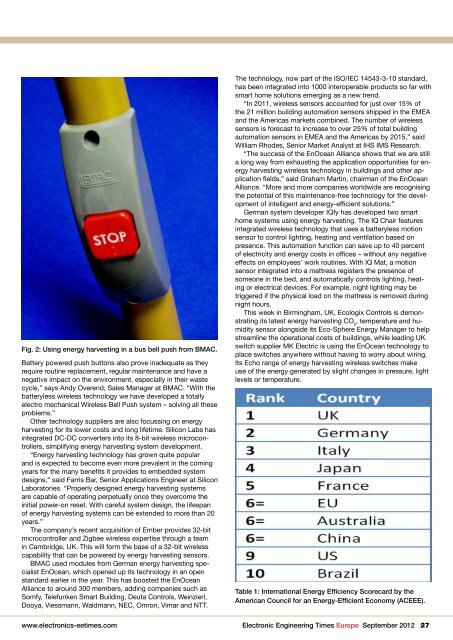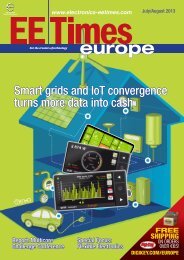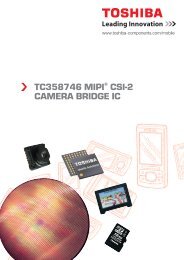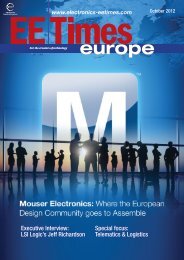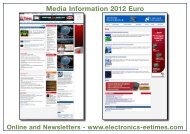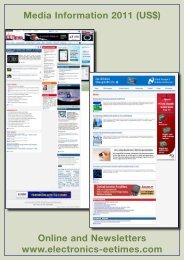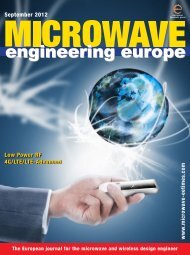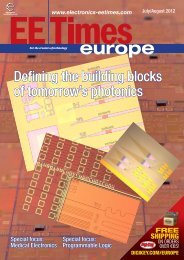Energy harvesting: a thin film approach - EE Times Europe
Energy harvesting: a thin film approach - EE Times Europe
Energy harvesting: a thin film approach - EE Times Europe
Create successful ePaper yourself
Turn your PDF publications into a flip-book with our unique Google optimized e-Paper software.
Fig. 2: Using energy <strong>harvesting</strong> in a bus bell push from BMAC.<br />
Battery powered push buttons also prove inadequate as they<br />
require routine replacement, regular maintenance and have a<br />
negative impact on the environment, especially in their waste<br />
cycle,” says Andy Overend, Sales Manager at BMAC. “With the<br />
batteryless wireless technology we have developed a totally<br />
electro mechanical Wireless Bell Push system – solving all these<br />
problems.”<br />
Other technology suppliers are also focussing on energy<br />
<strong>harvesting</strong> for its lower costs and long lifetime. Silicon Labs has<br />
integrated DC-DC converters into its 8-bit wireless microcontrollers,<br />
simplifying energy <strong>harvesting</strong> system development.<br />
“<strong>Energy</strong> <strong>harvesting</strong> technology has grown quite popular<br />
and is expected to become even more prevalent in the coming<br />
years for the many benefits it provides to embedded system<br />
designs,” said Farris Bar, Senior Applications Engineer at Silicon<br />
Laboratories. “Properly designed energy <strong>harvesting</strong> systems<br />
are capable of operating perpetually once they overcome the<br />
initial power-on reset. With careful system design, the lifespan<br />
of energy <strong>harvesting</strong> systems can be extended to more than 20<br />
years.”<br />
The company’s recent acquisition of Ember provides 32-bit<br />
microcontroller and Zigbee wireless expertise through a team<br />
in Cambridge, UK. This will form the base of a 32-bit wireless<br />
capability that can be powered by energy <strong>harvesting</strong> sensors.<br />
BMAC used modules from German energy <strong>harvesting</strong> specialist<br />
EnOcean, which opened up its technology in an open<br />
standard earlier in the year. This has boosted the EnOcean<br />
Alliance to around 300 members, adding companies such as<br />
Somfy, Telefunken Smart Building, Deuta Controls, Weinzierl,<br />
Dooya, Viessmann, Waldmann, NEC, Omron, Vimar and NTT.<br />
The technology, now part of the ISO/IEC 14543-3-10 standard,<br />
has been integrated into 1000 interoperable products so far with<br />
smart home solutions emerging as a new trend.<br />
“In 2011, wireless sensors accounted for just over 15% of<br />
the 21 million building automation sensors shipped in the EMEA<br />
and the Americas markets combined. The number of wireless<br />
sensors is forecast to increase to over 25% of total building<br />
automation sensors in EMEA and the Americas by 2015,” said<br />
William Rhodes, Senior Market Analyst at IHS IMS Research.<br />
“The success of the EnOcean Alliance shows that we are still<br />
a long way from exhausting the application opportunities for energy<br />
<strong>harvesting</strong> wireless technology in buildings and other application<br />
fields,” said Graham Martin, chairman of the EnOcean<br />
Alliance. “More and more companies worldwide are recognising<br />
the potential of this maintenance-free technology for the development<br />
of intelligent and energy-efficient solutions.”<br />
German system developer IQfy has developed two smart<br />
home systems using energy <strong>harvesting</strong>. The IQ Chair features<br />
integrated wireless technology that uses a batteryless motion<br />
sensor to control lighting, heating and ventilation based on<br />
presence. This automation function can save up to 40 percent<br />
of electricity and energy costs in offices – without any negative<br />
effects on employees’ work routines. With IQ Mat, a motion<br />
sensor integrated into a mattress registers the presence of<br />
someone in the bed, and automatically controls lighting, heating<br />
or electrical devices. For example, night lighting may be<br />
triggered if the physical load on the mattress is removed during<br />
night hours.<br />
This week in Birmingham, UK, Ecologix Controls is demonstrating<br />
its latest energy <strong>harvesting</strong> CO 2<br />
, temperature and humidity<br />
sensor alongside its Eco-Sphere <strong>Energy</strong> Manager to help<br />
streamline the operational costs of buildings, while leading UK<br />
switch supplier MK Electric is using the EnOcean technology to<br />
place switches anywhere without having to worry about wiring.<br />
Its Echo range of energy <strong>harvesting</strong> wireless switches make<br />
use of the energy generated by slight changes in pressure, light<br />
levels or temperature.<br />
Table 1: International <strong>Energy</strong> Efficiency Scorecard by the<br />
American Council for an <strong>Energy</strong>-Efficient Economy (AC<strong>EE</strong>E).<br />
www.electronics-eetimes.com Electronic Engineering <strong>Times</strong> <strong>Europe</strong> September 2012 27


